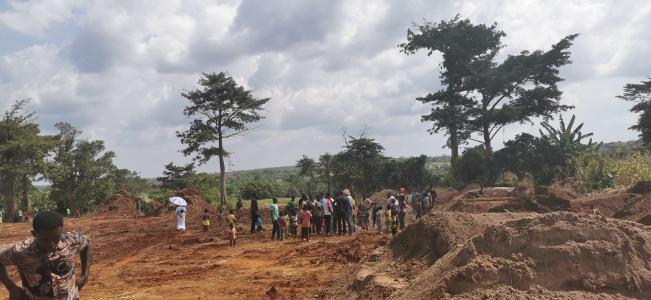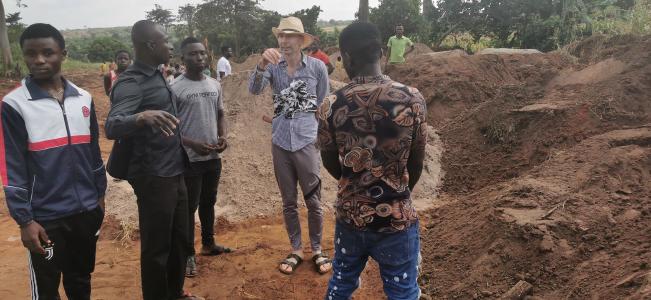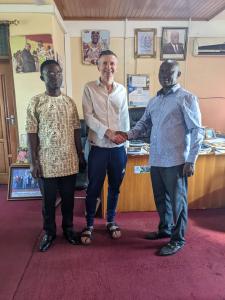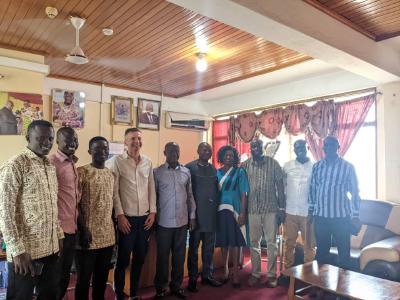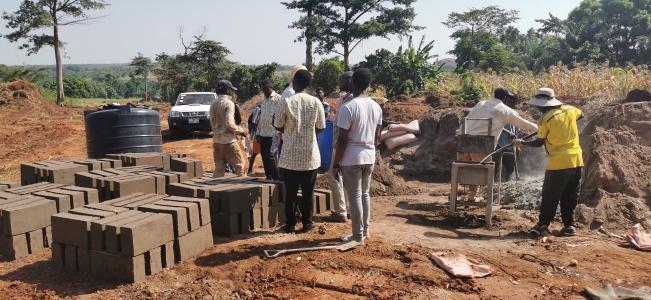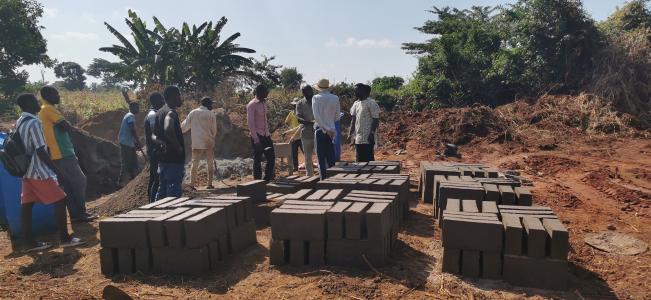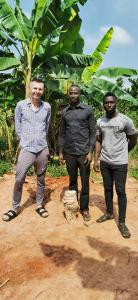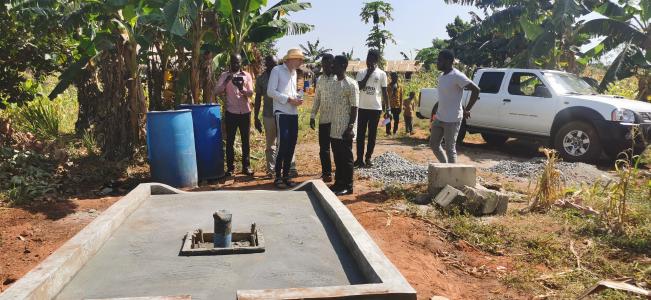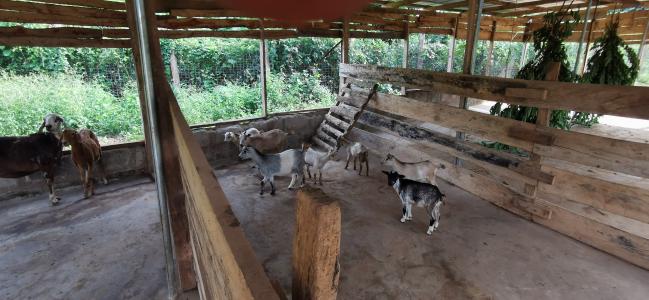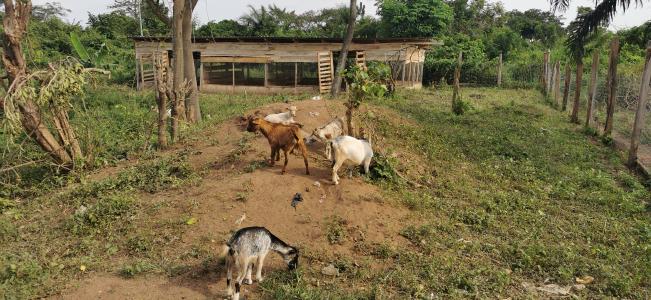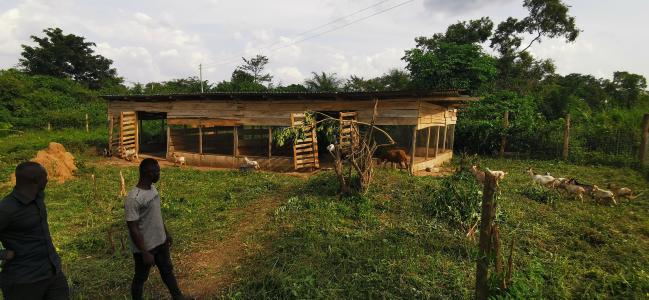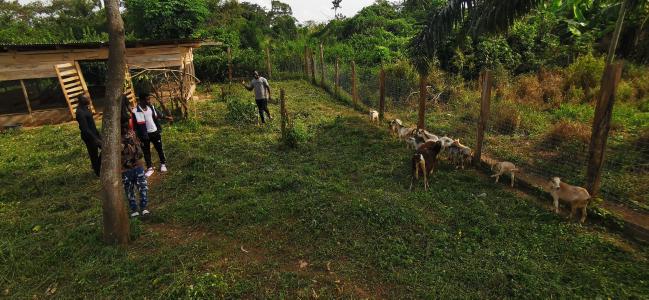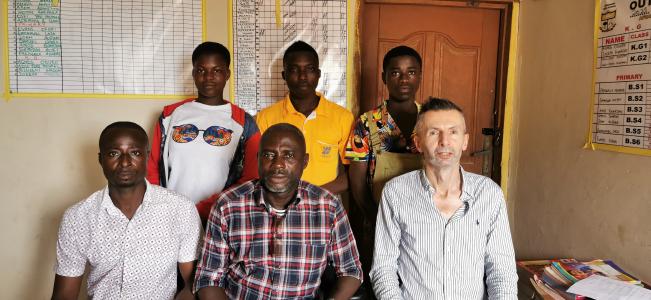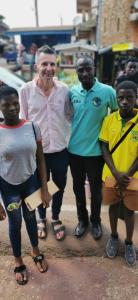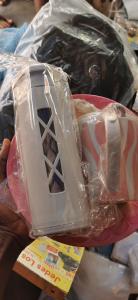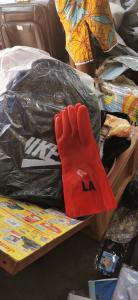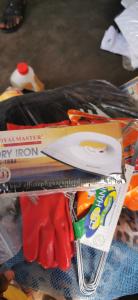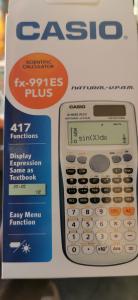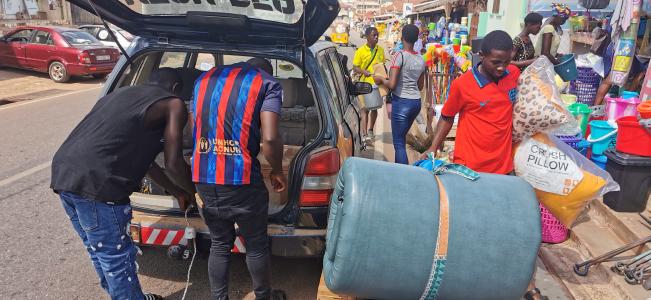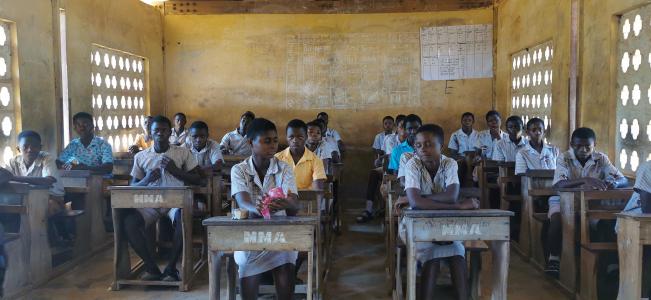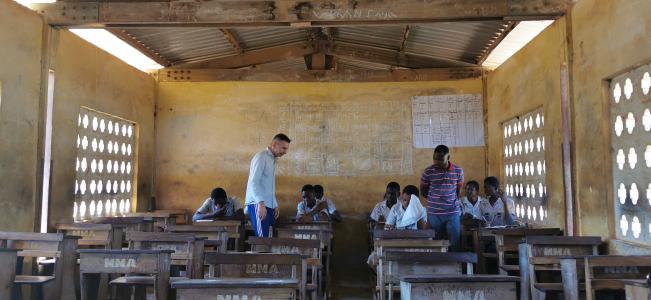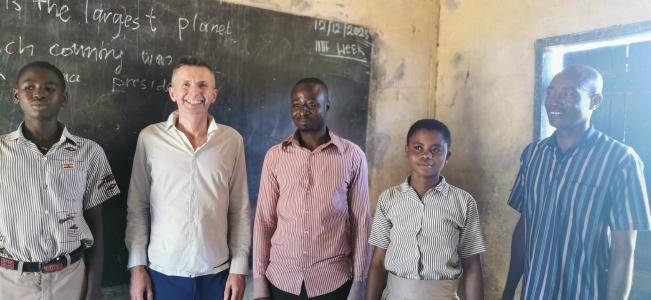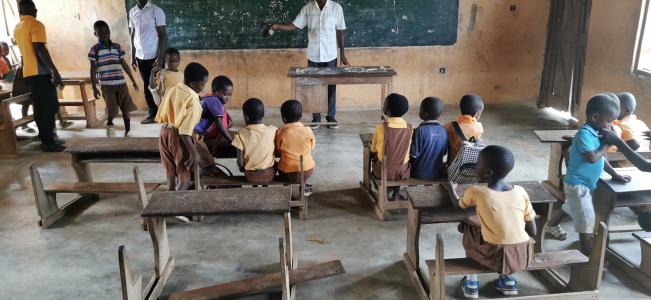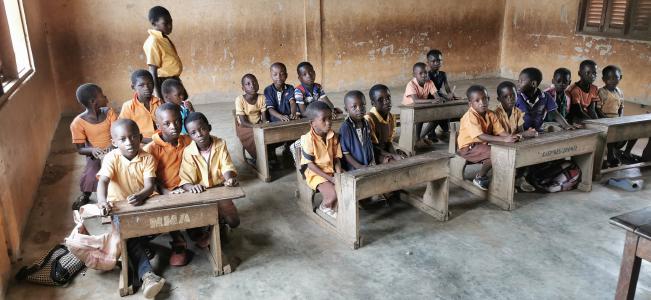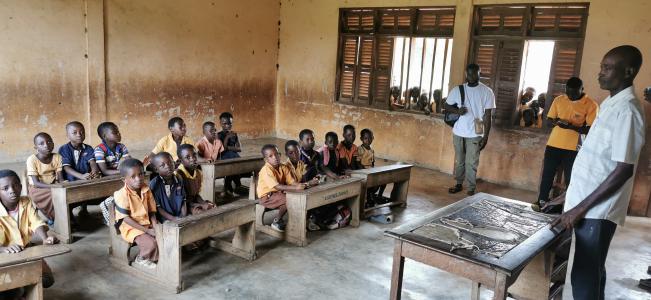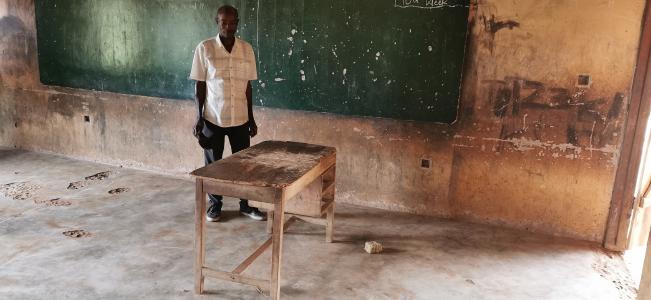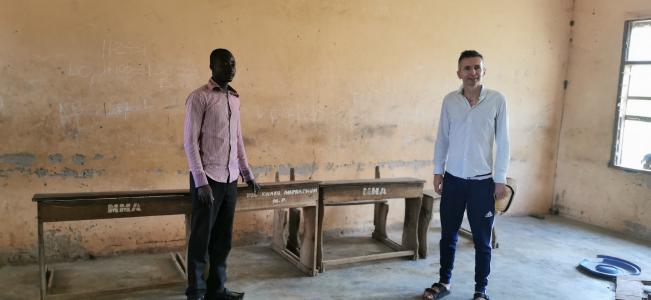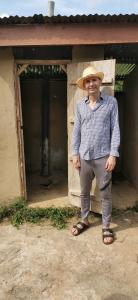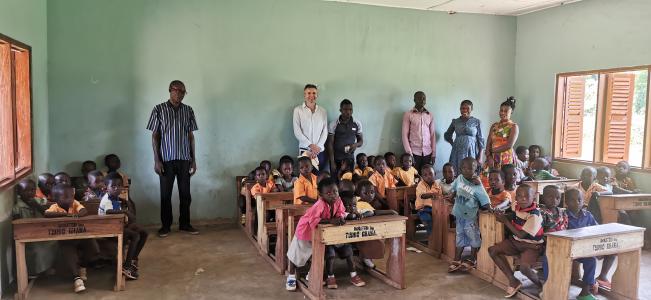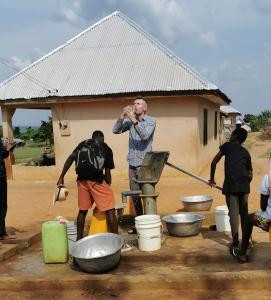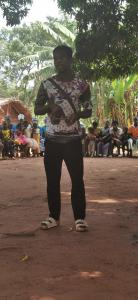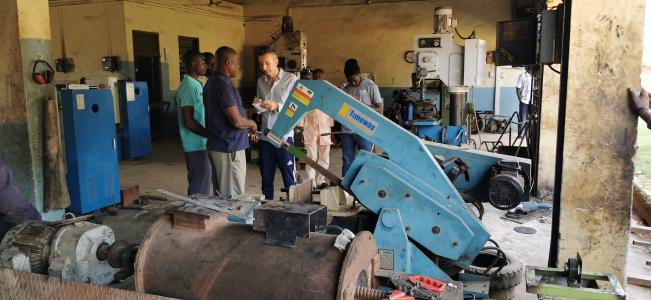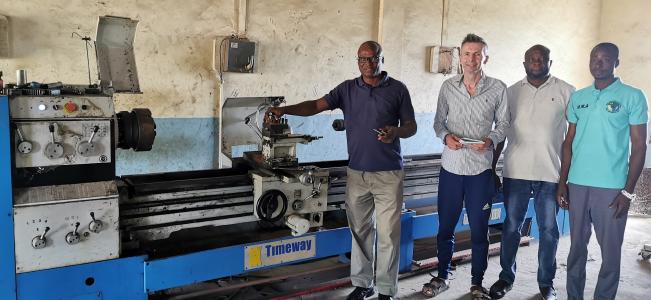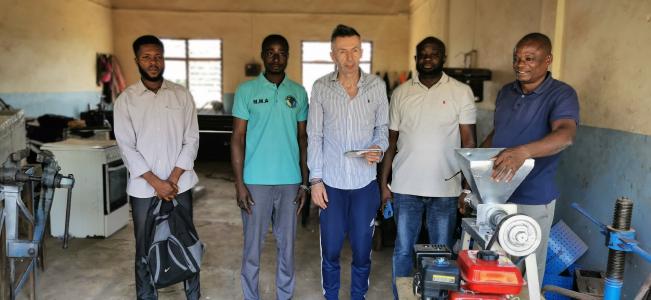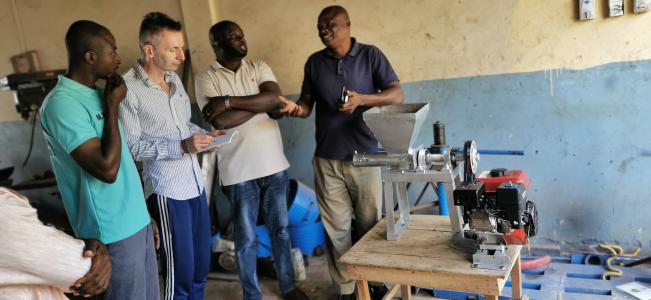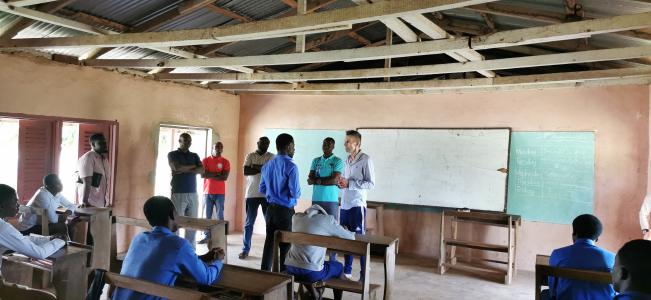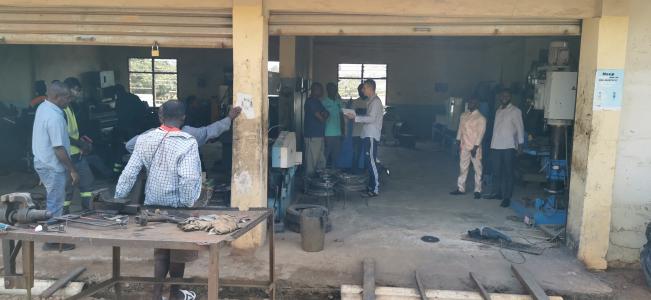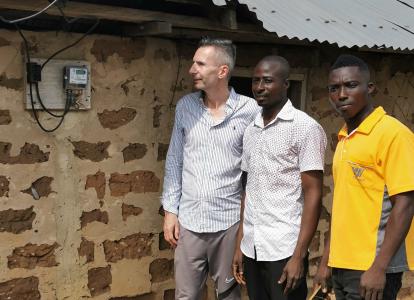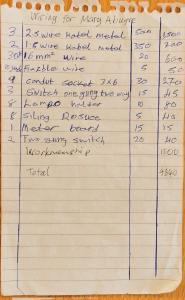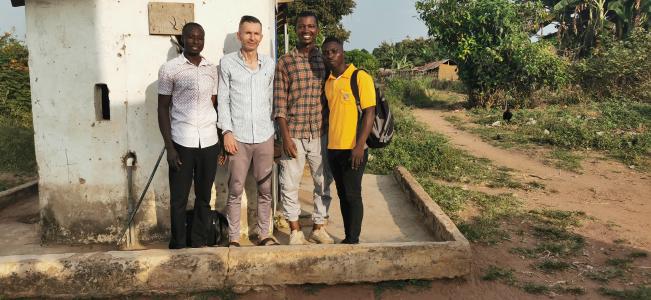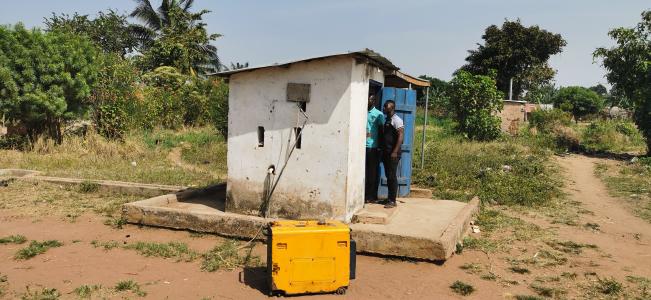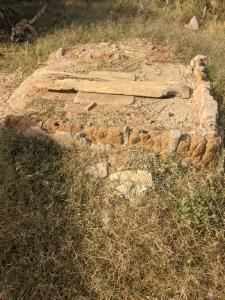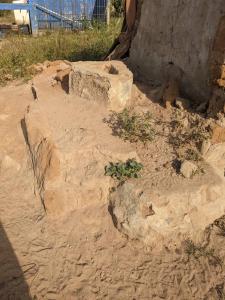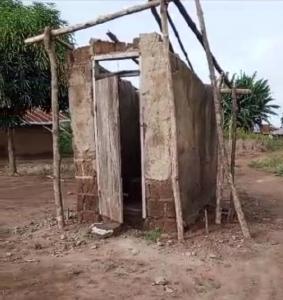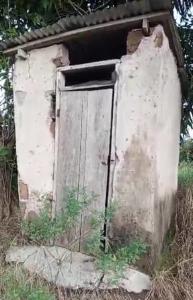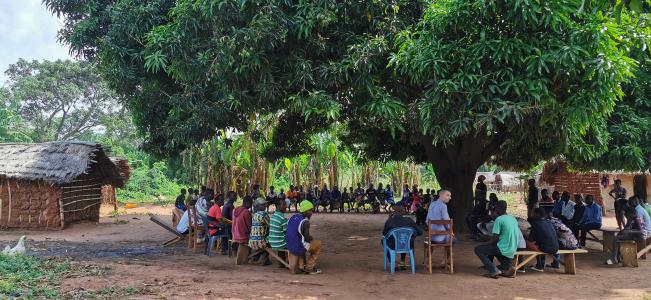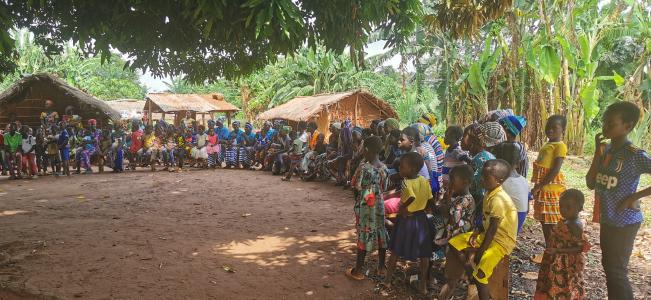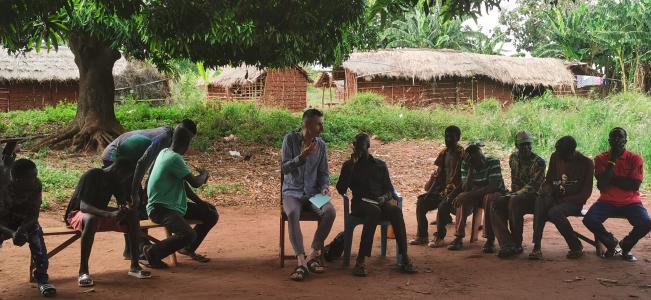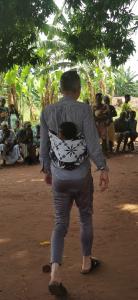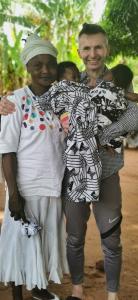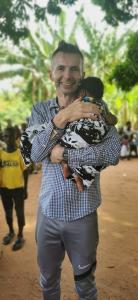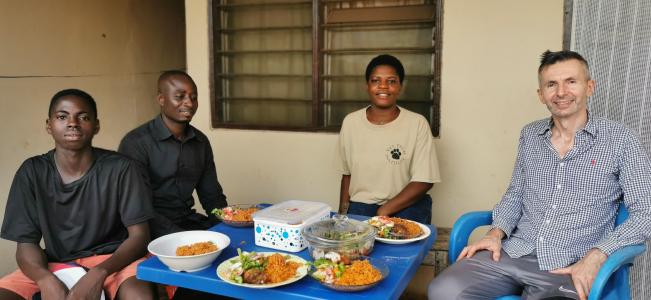Visit in December 2023
December 23, 2023
1. Kontonho school
Click on images for full size.
The site for the Kontonho school has been cleared, and the sand and gravel to make the blocks has been delivered. It is a huge quantity: 33 truckloads. They will make the building blocks onsite.
We had a meeting with the Municipal Chief Executive (MCE) Thomas Appiah, who has written a letter confirming that, after we donate the school building to the Education Department, they will indeed run our building as a school and provide teachers and learning materials and maintain the building.
While Mark was there, the masons started the arduous job of making 7000 blocks to build the school. Each one takes about one minute of intense work (mixing the sand and cement, filling the container, and pressing hard to form a block shape). In these photos they have made about 100 of them; a few days after Mark returned to England we heard that they have finished all 7000. (Update: see Kontonho school project page for more recent progress photos.)
2. Atonobi borehole
The borehole was drilled in November 2023 and when Mark arrived, there was just a stump. A few days later, the mason had finished the concrete base, but the pump was still missing. Shortly after Mark left, Kwasi got the pump fitted and now the pump is working. (Update: See Atonobi borehole project page for more recent progress photos.)
3. Sheep and goat rearing business
Turbo Ghana provided funds for the capital costs for Mrs Mary Abugre to start a sheep and goat rearing business. It looks like a great success. The animals are free to roam between the pen and the outdoor part. The outdoor part is large and has a lot of grass and leaves. The animals look happy and relaxed. At the time of Mark’s visit, Mrs Abugre was preparing to sell the goats in time for Christmas celebrations.
The capital costs covered the materials for animal pens and fencing, veterinary costs, and sheep and goat purchase costs. Mrs Abugre was the first instance of the business starter scheme. We will now broaden it and invite applications.
Another villager in Aframano is keeping cows, but they are not in a fenced area and hence have to be tied to a tree, and then moved from tree to tree in order to graze on new grass. Keeping animals like ducks, goats, sheep and cows in the open is common here, but it is not very good as the animals are at greater risk of predators, disease, theft and road accidents. The situation is much improved by keeping them in a large fenced area. If one is a cow, it is surely better to be in a fenced area than tied to a tree.
4. Student prospectus scholarship 2023
Emanuel and Ataa won a Turbo Ghana scholarship for their senior school prospectus in a competitive process in January 2023, when Mark visited last. He met them again, pictured here (top row left and right) with their head teacher (next to Mark).
The “prospectus” means the list of items (clothes, toiletries, kitchen equipment, bedding, …) - actually quite a long list - that they are required to join the school as boarding students. We bought the materials while Mark was there, since the children were starting their SHS school the following week.
5. Student prospectus scholarship 2024
We also started the process of selecting the students for next year. We will select four students. Two of them have been selected using a live competitive process run by Mark. It’s a knockout competition where the students answer questions, such as “What is one-half (1/2) plus one-third (1/3) expressed as a fraction?”, “With which country is Nelson Mandela associated?”, “Express 0.55 as a fraction”.
After 3 or 4 questions, one boy and one girl remained, and were selected. For the remaining two winners, we will select the students that do best in their final JHS exams (one girl, one boy). Unfortunately, gender parity in school attendance in Aframano is not yet a reality, with an overrepresentation of boys in the classroom. To encourage girls who do attend school to stay in education, Turbo Ghana is ensuring that at least one girl receives a prospectus per cycle.
6. Furniture in the main schools
We bought very nice furniture for the Aframano pre-school last year, but the furniture in the primary school and the JHS school is in dire need of repair. The teachers have asked Turbo Ghana to consider funding new furniture for them.
The furniture we will buy is hand-made locally using local wood. It’s beautiful, and as well as ensuring the school has nice furniture, it provides income to local carpenters.
7. Aframano pre-school and borehole
We met with teachers who now work at the Aframano kindergarten we built last year. The building is looking really nice. Agnes is a wonderful teacher with a really nice rapport with the young children in her class.
Happy to see that the latrines built for the school are also in good condition.
The borehole in Aframano remains our favourite of all our projects (2019). Whenever you pass it, it’s being used enthusiastically. It is so full of life and joyfulness, and the water there tastes so nice compared to the sachet water that people in the towns drink. Behind it are our teacher accommodation buildings built last year (2022), and nice to see they now have an electricity meter.
8. Apprenticeship scheme
The original idea for an apprenticeship scheme focussed on solar power. We’ve learned that this may be too restricted; the solar business may not be mature enough to support the apprentices after they graduate. So we are considering expanding the scheme, first to electricians, and then to other construction trades such as carpenters, tilers, masons.
When we talked to the community in Kontonho about this, one man stood up and said he wanted to apply for an apprenticeship to be an electrician. We asked him to write his name and number in our notebook. Then another 10 men also wrote their names. So it seems that the electrician apprenticeship will be popular.
It is clear that male candidates have a preference for male-dominated professions such as electricians, carpenters, tilers and masons. When discussing with female members of the community, the preference for apprenticeships is in dress making and hair dressing. These are less lucrative professions and supporting apprenticeships in those areas won’t close the gender gap between men and women longer-term. But we want to support women’s right to self-determination and to choose an apprenticeship most interesting to them, and we’re making all our apprenticeship schemes open to all genders. We hope to find schemes to allow for women empowerment longer-term.
Mark went to visit an existing government-funded apprenticeship scheme in Mampong, which focusses on making agricultural and industrial machinery. They have some serious equipment, including a lathe (left) and a power hacksaw.
They use this heavy equipment to make agricultural machinery, such as this food grinder.
They are looking for funding for welding machines (this is something they need quite a few of, because almost everything they make involves welding). They also need drawing boards and drawing utensils, for teaching the design stage of projects.
Mark met Prince Kanweta, who is from Aframano, and is a “master” (trainer) in surface finishing (this means all manners of finishing surfaces, such as spray painting, polishing, etc.).
9. Electricity in Aframano
Although grid electricity was promised “within a few months” in 2017 when Mark first visited, it has been very slow in coming. This year, there are some signs that it is arriving, and electricity meters are being installed. To qualify for an electricity meter, residents have to wire their house with sockets and lights at their own expense. The cost of wiring a typical house is about 5000 GHC (£320). This is the itemisation for Mrs Abugre’s house.
It raises the question of what we do with the solar installation we put for the mechanised borehole in Aframano. But this is still suffering teething problems, so they have to be resolved first as we haven’t fully paid for it yet. Mark spent many hours trying to resolve them, but he was defeated by difficult circumstances (delays getting people to come to diagnose problems and then a failed generator). When it’s resolved, we will consider moving the equipment to Kontonho, as grid electricity is unlikely to be installed there for many years.
10. Latrines in Aframano
This year has had very heavy rain, and for a much longer season than usual (climate change). Some of the latrines have been destroyed. We discussed this with Nicholas, the Ashanti Development officer, as he had managed their construction. His suggestion is that the method of using mud bricks (provided by community members) isn’t good enough any more, given the climate conditions. He suggested latrines should now be built using concrete blocks, at least for the first three courses. This is quite convincing. Indeed, Kwasi’s latrine is still standing and in good condition - he had used concrete blocks for the whole thing. Turbo Ghana can consider rebuilding with Nicholas’s suggested method.
11. A meeting with fun and laughter
A community meeting was held under the big tree in Kontonho, during which Mark heard about the reactions to the new borehole (in Atonobi) and the progress on the school, and he talked about future possible projects including the apprenticeship scheme. The way African women carry their children on their back is lovely, and Mark wanted to try it. Everyone thought this was very funny.
12. Social
Mark really enjoyed being a guest in a house in Bonkrong. A neighbour Christiana cooked food on a couple of occasions.
13. Possible future projects
For discussion among TG trustees.
-
Anyankammamu teachers’ accommodation. They have been seeking funding for this for two years now, but we prioritised the Kontonho school and the Atonobi borehole. Maybe their turn has come. Maybe £15K.
-
Aframano JHS and primary school furniture (see above). Maybe £4K.
-
More business starters. £3-10K.
-
Rebuilding Aframano latrines. £10K?
-
Apprenticeship scheme. This needs more thinking about, but we have begun to collect apprentice candidates names and also “master” (trainer) names. We might be in a position to interview in February 2024. £5-15K.
-
Anyankammamu village borehole. We haven’t visited it yet (maybe Mark can do that in February 2024), but Kwasi recommends it. £6K.
-
SHS prospectus expansion. £2K
-
We have also received three appeal letters: letter1, letter2, and letter3 (two letters in one file).
14. Hugo shortcuts, html and css
Hugo is the name of the framework we’re using to generate this website. Here is a demo of the Hugo “shortcuts” I’ve written to make nice arrangements of images. Don’t worry, it only took me three days to figure out the necessary html, css, and Hugo constructs ☻.
